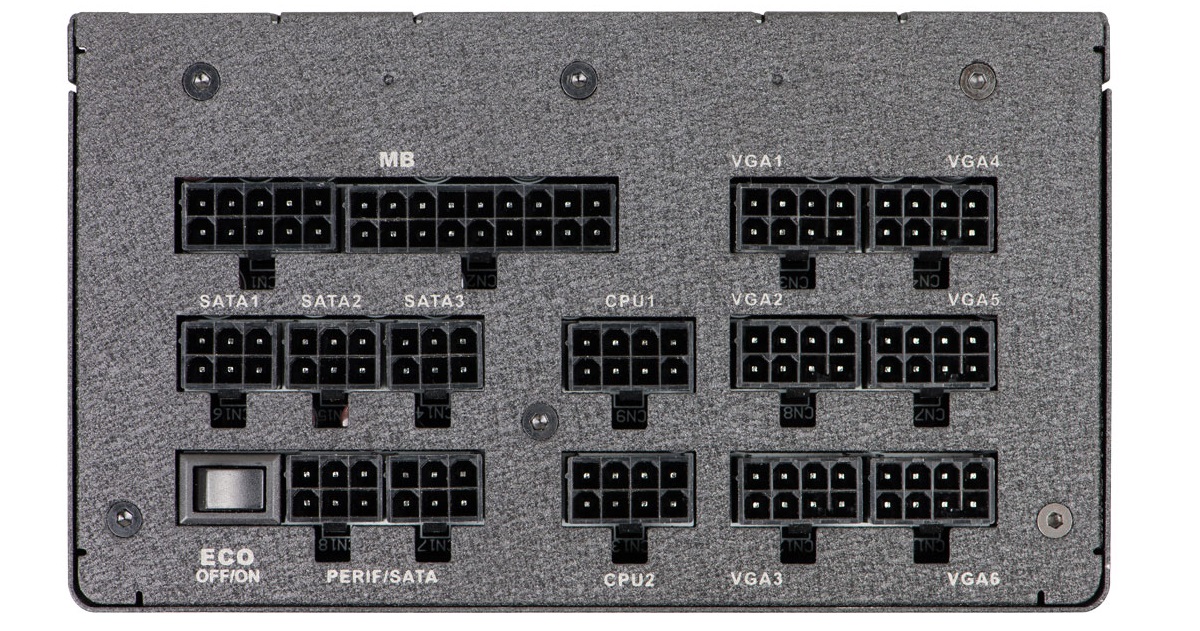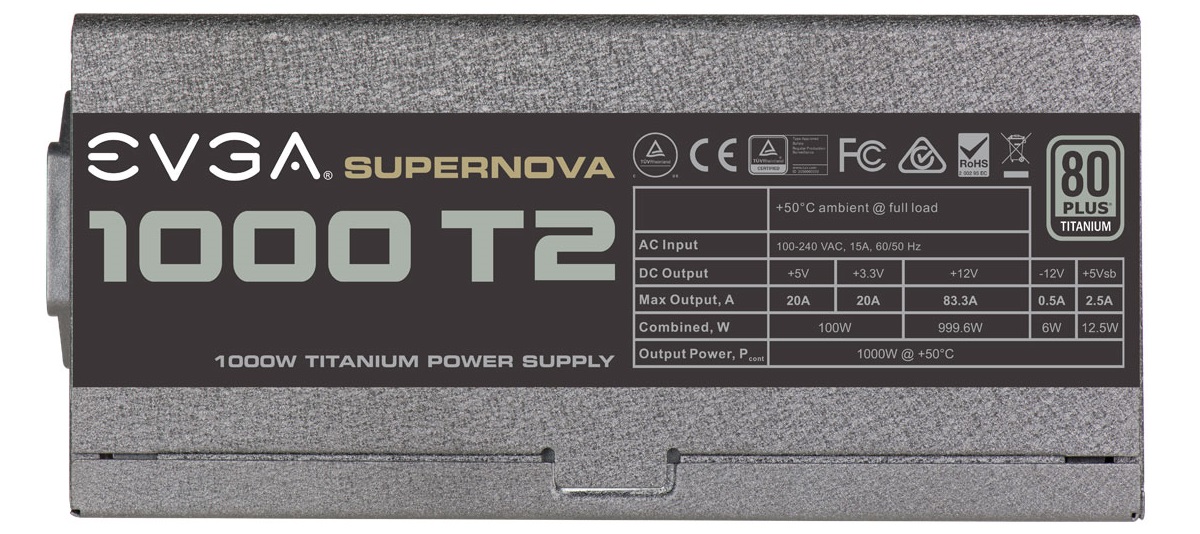Evga Brings Titanium Label To Its Sub-1000 W PSUs
CES just ended, but Evga is already here announcing new products. Today, these are the SuperNova 1000, 850, and 750 T2 power supplies, which, you guessed it, have power envelopes of 1000 W, 850 W, and 750 W, respectively.
The SuperNova T2 series was launched roughly a year ago, starting with the SuperNova 1600 T2. These units are the most high-end power-supplies that Evga makes and come with an impressive Titanium 80-Plus label. Of course, not everybody wants to buy a 1600 W PSU in order to obtain a PSU with a Titanium label, so Evga built lower-power units, too.
On the U.S. grid, 80 Plus Titanium PSUs are required to be 94 percent efficient or higher, whereas in 220-240V grids this number is bumped to 96 percent.
The SuperNova 1000, 850, and 750 T2 units follow in the footsteps of their older brothers, with matching feature sets. They are all fully modular and have an Eco mode that turns off the fan when temperatures drop below the 45°C threshold. Their internal design is built on a single powerful 12V rail, which takes the guesswork out of spreading loads (granted, multiple 12V rails are becoming a thing of the past). A 140 mm fan with a dual-ball bearing takes care of cooling.
Unsurprisingly, they also have all the protection mechanisms we’ve come to expect from power supplies these days, including overvolt, undervolt, over-power, short-circuit, over-current, and overheating protections.
The OEM that Evga normally uses for its PSUs is the Taiwan-based Super-Flower, and these units are no exception. For the capacitors, SuperFlower and Evga exclusively use Japanese solid-state capacitors for reliability and longevity reasons.
Pricing sits at $279.99, $239.99, and $219.99 for the SuperNova 1000, 850, and 750 T2 power supplies, respectively. They can be purchased directly from Evga and will be making their way to the usual resellers soon. These are steep prices, but note that they do come with a 10-year warranty, so even if you’re unlucky enough to have one go bad, Evga’s still got your back.
Get Tom's Hardware's best news and in-depth reviews, straight to your inbox.
Follow Niels Broekhuijsen @NBroekhuijsen. Follow us @tomshardware, on Facebook and on Google+.
Niels Broekhuijsen is a Contributing Writer for Tom's Hardware US. He reviews cases, water cooling and pc builds.
-
toddybody How does SuperFlower compare to other OEMs? Is Seasonic still "the best"? PSU OEM ranking is still nebulous to me.Reply -
AdviserKulikov SuperFlower is a top tier OEM for PSUs. Good to see they continue pushing out top tier equipment at reasonable prices.Reply -
Lutfij I would love to read up on a review of those units. The 750W unit looks interesting to say the least. Though the prices on them look a little bit high/inflated - probably since they aren't seeing any competitors offering the same solution in the same power envelope...?Reply -
babernet_1 I wonder how quiet they are? Should be quiet with the Titanium efficiency. How will they compare with Thermaltake and Seasonic's Titaniums?Reply -
dstarr3 Reply17309966 said:I wonder how quiet they are? Should be quiet with the Titanium efficiency. How will they compare with Thermaltake and Seasonic's Titaniums?
It has what EVGA is calling "Eco mode," which means that while the PSU is operating under a certain percentage of its capacity (I think 40%, could be wrong), the fan doesn't even turn on. So at idle and during most tasks, it'll be completely silent.
I have a similar PSU from SuperFlower under a different brand name, I got an 850W for an amazing price when really, a 600W probably would have been fine for my system. I'm pretty sure the fan has never turned on in the past three years.
On another computer, I have an EVGA G2 650W, which is another SuperFlower PSU with this Eco mode. If the fan has ever turned on yet, I've never heard it. -
dudmont I have 2 of the Supernova P2s. They aren't detectable in terms of noise. Even when the load is up, I don't hear them(of course, I have other fans that are loud, so I never hear the PSU:)).Reply -
turkey3_scratch Exclusively solid Japanese caps... Even better than exclusively Japanese electrolytics! Dual ball bearing fan, even better. Prices, quite reasonable, plus some day they'll probably drop.Reply
Am I the only one who notices the ECO mode switch is by the modular connectors rather than the back by the AC receptacle? So to turn on ECO more you now have to open your case I guess? That's not cool. -
dstarr3 Reply17311780 said:Am I the only one who notices the ECO mode switch is by the modular connectors rather than the back by the AC receptacle? So to turn on ECO more you now have to open your case I guess? That's not cool.
I thought that at first, too. But then again, how frequently do you expect to change that? If at all? I certainly don't have any motivation to flip the switch off of Eco mode.



